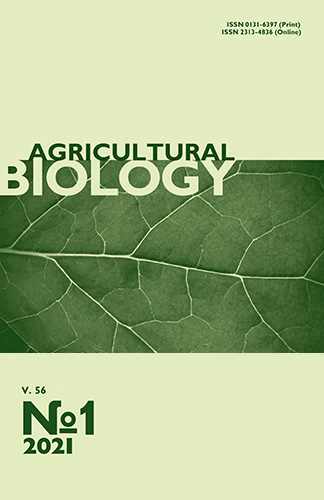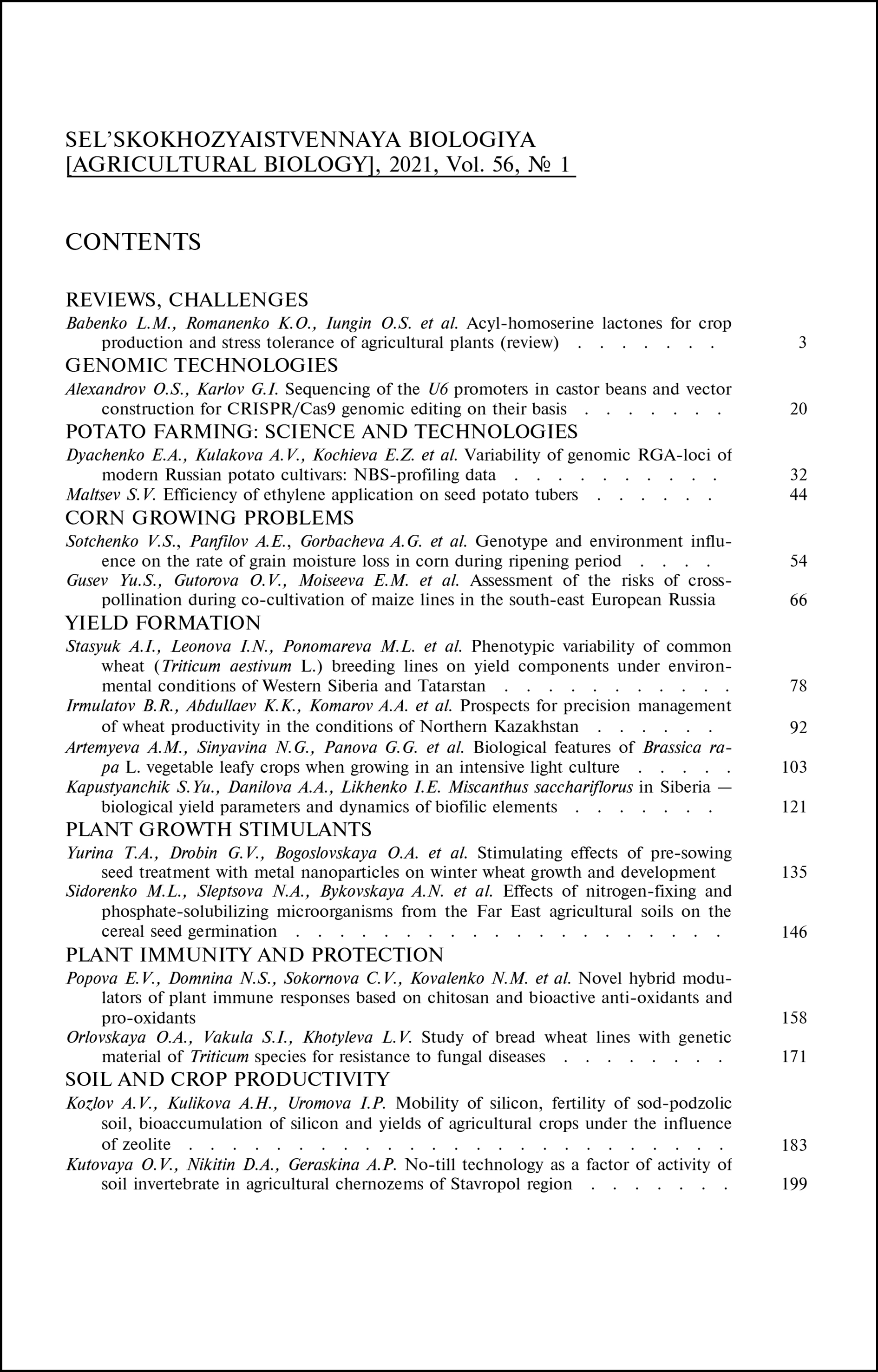doi: 10.15389/agrobiology.2021.1.171eng
UDC: 633.11:632.4
STUDY OF BREAD WHEAT LINES WITH GENETIC MATERIAL OF Triticum SPECIES FOR RESISTANCE TO FUNGAL DISEASES
O.A. Orlovskaya ✉, S.I. Vakula, L.V. Khotyleva
Institute of Genetic and Cytology of National Academy of Science of Belarus, 27, ul. Akademicheskaya, Minsk, 220072 Republic of Belarus, e-mail O.Orlovskata@igc.by (✉ corresponding author), svettera@yandex.ru, L.Khotyleva@igc.by
ORCID:
Orlovskaya O.A. orcid.org/0000-0002-1187-1317
Khotyleva L.V. orcid.org/0000-0003-0295-5022
Vakula S.I. orcid.org/0000-0002-2242-7107
Received October 9, 2020
Triticum aestivum L. yield losses caused by phytopathogens can reach 40-80 % in epiphytotic years. Wild and cultivated relatives of common wheat are promising sources of broadening the genetic diversity of resistance loci for modern varieties. For the first time differences in the degree of infection by fungal pathogens of wheat lines obtained from crossing with Triticum dicoccoides, T. dicoccum, T. durum, T. kiharae were shown on the basis of long-term monitoring under conditions of the natural infectious background of Belarus. In our work, we studied the resistance of bread wheat lines with Triticumspecies introgressions to powdery mildew (Blumeria graminis), septoria (Zymoseptoria tritici), and leaf rust (Puccinia triticina) in a natural infectious background. We studied 30 introgression lines obtained in the Institute of genetics and cytology NAS of Belarus from crossing of six varieties of common wheat (Rassvet, Saratovskaya 29, Festivalnaya, Chinese Spring, Belorusskaya 80, Pitic S62) with accessions of tetraploid species T. dicoccoides, T. dicoccum, T. durum (ААВВ, 2n = 28) and with hexaploid synthetic variety T. kiharae (AtAtGGDD, 2n = 42). Twelve of the studied wheat lines were obtained with T. durum contribution, 7 — with T. dicoccoides, 6 – with T. kiharae, 5 — with T. dicoccum. The evaluation of resistance to the diseases was performed in a naturally occurring infectious background on the experimental fields of the Institute of Genetics and Cytology of the NAS of Belarus during 2012, 2014-2016, 2018, 2019 field seasons using Geshele’s scale. We used the extent of flag leaf damage in the milky-wax ripeness phase as an indicator of resistance: 0-5 % — highly resistant plants, 5-10 % — resistant, 10-15 % — medium resistant, 15-25 % — medium susceptible, 25-40 % — susceptible. Statistica 10.0 software package was used for statistics (Kruskal-Wallis test, box-and-whiskers diagram, two-way ANOVA). The extent of flag leaf damage for the susceptible spring bread wheat variety Thatcher accounted 40-60 % by B. graminis and 15-25 % by Z. tritici during studied period. P. triticina, which causes wheat leaf rust, was detected only in 2012 and 2014 in a naturally occurring infectious background of Belarus (the degree of damage of susceptible control was 50 %). ANOVA confirmed the differences in the average degree of damage to wheat plants by fungal pathogens under weather conditions of six field seasons (p < 0,01). The highest sensitivity of wheat lines to powdery mildew and leaf rust was noted in 2014, to septoria blight — in 2012. The weather conditions of these years contributed to the intensive development of diseases (high precipitation, relatively low average daily air temperatures, Selyaninov's hydrothermal coefficient above 1.5). The least favorable conditions for the development of fungal pathogens were recorded in dry 2015 year (hydrothermal coefficient = 0.7). The species of genus Triticum were superior to common wheat varieties in resistance to fungal diseases. It was found that 60.0 % of introgression lines showed a high level of resistance to leaf rust, 56.7 % to septoria, and 36.7 % to powdery mildew. The highest number of highly resistant to powdery mildew and septoria genotypes were noted among the lines created on the base of T. dicoccoides (71.4 % and 85.7 %, respectively). Resistance to leaf rust (80 %) was common among lines with T. dicoccum genetic material. A significant statistical difference in the degree of damage by powdery mildew and septoria was shown between the groups of lines created using the species T. dicoccoides, T. dicoccum, T. durum, T. kiharae, and under different weather conditions. A total of 26.7 % of introgression lines demonstrated resistant to two diseases (lines 11-1, 13-3, 15-7-2, 16-5, 34-1, 34-2, 183/2-2, 184/1-6), 23.3 % — to three infections (lines 29, 8, 15-7-1, 1-3, 2-7, 19, 25-2). These lines are of interest in breeding for fungal disease resistance.
Keywords: genus Triticum, introgression lines, powdery mildew, septoria, leaf rust.
REFERENCES
- Figueroa M., Hammond-Kosack K.E., Solomon P.S. A review of wheat diseases — a field perspective. Molecular Plant Pathology, 2018, 19(6): 1523-1536 CrossRef
- Luck J., Spackman M., Freeman A., Trebicki P., Griffiths W., Finlay K., Chakraborty S. Climate change and diseases of food crops. Plant Pathology, 2011, 60(1): 113-121 CrossRef
- Röll G., Batchelor W.D., Castro A.C., Simón M.R., Graeff-Hönninger S. Development and evaluation of a leaf disease damage extension in Cropsim-CERES wheat. Agronomy, 2019, 9(3): 120 CrossRef
- Duveiller E., Singh R.P., Nicol J.M. The challenges of maintaining wheat productivity: pests, diseases, and potential epidemics. Euphytica, 2007, 157(3): 417-430 CrossRef
- McIntosh R.A., Dubcovsky J., Rogers J., Morris C., Xia X.C. Catalogue of gene symbols for wheat: 2017 supplement. Available: http://www.shigen.nig.ac.jp/wheat/komugi/genes/symbolClassList.jsp. Accessed: 20.05.2020.
- Pakholkova E.V., Sal'nikova N.N., Kurkova N.A. Genetic structure of regional populations of Mycosphaerella graminicola (Septoria tritici), the septoria leaf blotch agent of wheat (Triticum aestivum L.). Sel'skokhozyaistvennaya biologiya, 2016, 51(5): 722-730 CrossRef
- Stadlmeier M., Jørgensen L.N., Corsi B., Cockram J., Hartl L., Mohler V. Genetic dissection of resistance to the three fungal plant pathogens Blumeria graminis, Zymoseptoria tritici, and Pyrenophora tritici-repentis using a multiparental winter wheat population. G3 (Bethesda), 2019, 9(5): 1745-1757 CrossRef
- Disease resistance in wheat. I. Sharma (ed.). CABI, Wallingford, 2012.
- Davoyan E.R., Davoyan R.O., Bebyakina I.V., Davoyan O.R., Zubanova YU.S., Zinchenko A.N., Kravchenko A.M. Vavilovskii zhurnal genetiki i selektsii, 2012, 16(1): 116-122 (in Russ.).
- Pietrusinska A., Żurek M., Piechota U., Słowacki P., Smolinska K. Searching for diseases resistance sources in old cultivars, landraces and wild relatives of cereals. A review. Annales UMCS sectio E Agricultura,2019, LXXIII(4): 45-60 CrossRef
- Leonova I.N., Badaeva E.D., Orlovskaya O.A., Roder M.S., Khotyleva L.V., Salina E.A., Shumnyi V.K. Genetika, 2013, 49(11): 1276-1283 CrossRef (in Russ.).
- Orlovskaya O.A., Solovei L.A., Dubovets N.I., Khotyleva L.V. Molekulyarnaya i prikladnaya genetika, 2019, 27: 52-61 (in Russ.).
- Geshele E.E. Osnovy fitopatologicheskoi otsenki v selektsii rastenii [Fundamentals of phytopathological assessment in plant breeding]. Moscow, 1978 (in Russ.).
- Arraiano L., Brown J. Sources of resistance and susceptibility to Septoria tritici blotch of wheat: resistance and susceptibility to Septoria of wheat. Molecular Plant Pathology, 2016, 18(2): 276-292 CrossRef
- Ferjaoui S., M'Barek S.B., Bahri B., Slimane R.B., Hamza S. Identification of resistance sources to Septoria tritici blotch in old Tunisian durum wheat germplasm applied for the analysis of the Zymoseptoria tritici-durum wheat interaction. Journal of Plant Pathology, 2015, 97(3): 471-481 CrossRef
- Herrera-Foessel S.A., Singh R.P, Huerta-Espino J., William H.M, Garcia V., Djurle A., Yuen J. Identification and molecular characterization of leaf rust resistance gene Lr14a in durum wheat. Plant Disease, 2008, 92(3): 469-473 CrossRef
- Gill B.S., Huang L., Kuraparthy V., Raupp W.J., Wilson D.L., Friebe B. Alien genetic resources for wheat leaf rust resistance, cytogenetic transfer, and molecular analysis. Australian Journal of Agricultural Research, 2008, 59(3): 197-208 CrossRef
- Narang D., Kaur S., Steuernagel B. Ghosh S., Bansal U., Li J., Zhang P., Bhardwaj S., Uauy C., Wulff B.B.H., Chhuneja P. Discovery and characterisation of a new leaf rust resistance gene introgressed in wheat from wild wheat Aegilops peregrina. Sci. Rep., 2020, 10(1): 7573 CrossRef
- Aktar-Uz-Zaman M., Tuhina-Khatun M., Hanafi M.M., Sahebi M. Genetic analysis of rust resistance genes in global wheat cultivars: an overview. Biotechnology & Biotechnological Equipment, 2017, 31(3): 431-445 CrossRef
- Gul'tyaeva E.I., Sibikeev S.N., Druzhin A.E., Shaidayuk E.L. Enlargement of genetic diversity of spring bread wheat resistance to leaf rust (Puccinia triticina Eriks.) in Lower Volga region. Sel'skokhozyaistvennaya biologiya [Agricultural Biology], 2020, 55(1): 27-44 CrossRef
- Peng J.H., Sun D.F., Peng Y.L., Nevo E. Gene discovery in Triticum dicoccoides, the direct progenitor of cultivated wheats. Cereal Research Communications, 2013, 41(1): 1-22 CrossRef
- Hua W., Liu Z., Zhu J., Xie C., Yang T., Zhou Y., Duan X., Sun Q., Liu Z. Identification and genetic mapping of pm42, a new recessive wheat powdery mildew resistance gene derived from wild emmer (Triticum turgidum var. dicoccoides). Theor. Appl. Genet., 2009, 119: 223-230 CrossRef
- Akhmedov M.A. Genetika, 1998, 34(10): 1376-1382 (in Russ.).
- Kang Y., Zhou M., Merry A.M., Barry K.M. Mechanisms of powdery mildew resistance of wheat — a review of molecular breeding. Plant Pathology, 2020, 69(4): 611-617 CrossRef
- Markelova T.S., Ivanova O.V., Baukenova E.A., Naryshkina E.A., Salmova M.F. Agrarnyi vestnik Yugo-Vostoka, 2014, 1-2: 25-27 (in Russ.).
- Belan I.A. Rossiiskaya sel'skokhozyaistvennaya nauka, 2016, 1: 5‑8 (in Russ.).
- Ben-David R., Xie W., Peleg Z., Saranga Y., Dinoor A., Fahima T. Identification and mapping of PmG16, a powdery mildew resistance gene derived from wild emmer wheat. Theor. Appl. Genet., 2010, 121(3): 499-510 CrossRef
- Liu X., Zhang M., Liu X., Li H., Hao M., Ning Sh., Yuan Zh., Liu D., Wu B., Chen X., Chen W., Zhang L. Molecular cytogenetic identification of newly synthetic Triticum kiharae with high resistance to stripe rust. Genetic Resources and Crop Evolution, 2018, 65: 1725-1732 CrossRef
- Smekalova T.N., Kobylyanskii V.D. Trudy po prikladnoi botanike, genetike i selektsii, 2019, 180(4): 148-151 (in Russ.).
- Markelova T.S., Vedeneeva M.L., Kirillova T.V. Vestnik zashchity rastenii, 2003, 3: 25-30 (in Russ.).
- Bashir T., Mishra R.C., Hasan M.M., Mohanta T.K., Bae H. Effect of hybridization on somatic mutations and genomic rearrangements in plants. International Journal of Molecular Science, 2018, 19(12): 3758 CrossRef
- Whitford R., Fleury D., Reif J.C., Garcia M., Okada T., Korzun V., Langridge P. Hybrid breeding in wheat: technologies to improve hybrid wheat seed production. Journal of Experimental Botany, 2013, 64(18): 5411-5428 CrossRef
- Badaeva E.D., Budashkina E.B., Bilinskaya E.N., Pukhalskiy V.A. Intergenomic chromosome substitutions in wheat interspecific hybrids and their use in the development of a genetic nomenclature of Triticum timopheevii chromosomes. Russian Journal of Genetics, 2010, 46(7): 769-785.
- Petrash N., Leonova I., Adonina I., Salina E. Effect of translocations from Aegilops speltoides Tausch on resistance to fungal diseases and productivity in common wheat. Russian Journal of Genetics, 2016, 52(12): 1253-1262 CrossRef
- Orlovskaya O.A., Dubovets N.I., Solovey L.A., Bondarevich E.B., Leonova I.N. Molecular cytogenetic analysis of alien introgressions in common wheat lines with T. kiharae genetic material. Proc. of the Fifth International scientific conference «Current challenges in plant genetics, genomics, bioinformatics, and biotechnology». A. Kochetov, E. Salina (eds.). Novosibirsk, 2019: 235-237.












